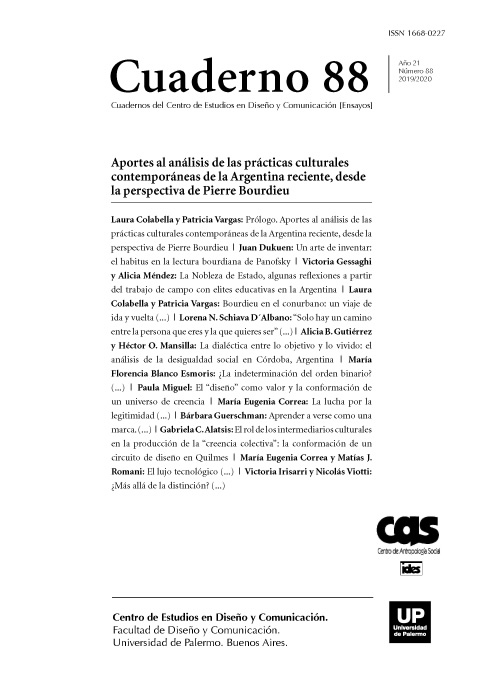Aprender a verse como una marca. El cálculo, tiempo y ethos en Argelia 60
Abstract
The aim of this article is to describe the process by which a group of costume designers are recognized as brands by other fashion agents with whom they are linked to make and display their seasonal collections: modelers, marketing consultants, stylists, fashion producers and owners of multibrand stores. My purpose is to understand in what ways, in the course of this process, the designers incorporate the “calculation” in their conduct as an ethic that, as defined by Pierre Bourdieu, is constitutive of the capitalist economy and implies the temporary perception of the future distanced from the immediate present that characterizes precapitalist economies.Taking into account my ethnographic field work carried out between 2005 and 2018, I will analyze how they apprehend such ethics when marketing the collections, in spaces such as retail venues, multibrand stores and biannual fashion events.
References
Bourdieu, P. (1990). “Alta costura y Alta cultura”. Sociología y Cultura. México. Grijalbo.
__________. (1990). “El campo literario. Prerrequisitos críticos y principios de método”. Criterios La Habanna. Núm 25-28. pp 20-42.
__________. (1990). “Algunas propiedades de los campos”. Sociología y Cultura. México. Grijalbo.
__________. (1997). “Espíritus de Estado. Génesis y estructura del campo burocrático”, en Razones Prácticas. Sobre la teoría de la acción. Barcelona. Anagrama.
__________. (1998) La Distinción. Criterio y bases sociales del gusto. Madrid. Taurus.
__________. (2001). Qué significa hablar. Madrid. Akal Editores.
__________. (2002). Las estructuras sociales de la Economía. Buenos Aires. Editorial Manantial.
__________. (2006). Argelia 60. Estructuras económicas y estructuras temporales. Buenos Aires. Editorial Siglo XXI.
Callon, M. (2008). “Los mercados y la performatividad de las ciencias económicas”. Apuntes de Investigación Cecyp. Tema Central Economía. No 14.
Davis, F. (1992). Fashion, Culture and Identity. University of Chicago Press.
Douglas, M. (1973) Pureza y Peligro. Un análisis de los conceptos de contaminación y tabú. México. Siglo XXI editores.
Lamont, M. y Molnar, V. (2002). The Study of Boundaries in the Social Sciences. Annual Review of Sociology. Vol 28: 167-95.
Marion, G. (2006). “Research Note: Marketing ideology and criticism: Legitimacy and legitimization”. Marketing Theory. Vol 6. pp 245-262.
Rocamora, A. (2002). “Fields of Fashion. Critical Insights into Bourdieu´s Sociology of Culture”. Journal of Consumer Culture. Vol 2(3): 341-362.
Rutz, H. (1992). The Politics of Time. AES Monography Number 4.
Thompson, E. (1989). “Tiempo, disciplina de trabajo y capitalismo industrial”. Tradición, revuelta y conciencia de clase. Estudios sobre la crisis en la sociedad industrial. México. Grijalbo.
Weber, M. (1993). La ética protestante y el espíritu del capitalismo. Barcelona. Ediciones Península.
Weller, S. (2007). “Fashion as viscous knowledge: fashion’s role in shaping trans-national garment production”. Journal of Economic Geography. Vol 7. pp 39-66.
Los autores/as que publiquen en esta revista ceden los derechos de autor y de publicación a "Cuadernos del Centro de Estudios de Diseño y Comunicación", Aceptando el registro de su trabajo bajo una licencia de atribución de Creative Commons, que permite a terceros utilizar lo publicado siempre que de el crédito pertinente a los autores y a esta revista.


